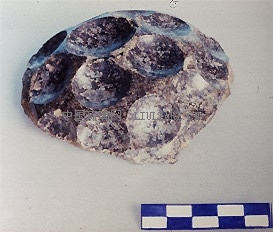To date, no actual examples of such western ware have been found in China; but on a painted silk banner from the Buddhist caves at Tun Huang, a Boddhisatva holds one of these Partho-Sasanian faceted bowls so that his hand is visible through the sparkling pale green glass. Thus, this striking portrayal vividly documents the presence of western glass at a remote outpost along the Central Asian Silk Route. Further evidence of the Chinese interest in glass from the world of Rome comes in the form of lyrical poems composed by the nobility in praise of such luxury vessels which had ". . . braved the perils of the desert's limitless wastes, / And crossed the towering, precipitous Pamirs" in order to grace their tables:
Despite the vernal splendor of its hue,
Its clarity surpasses the purest winter ice.
There vessels are produced as though ceramic,
And their rare foreign shapes richly embellished.
The tour de force of Roman glass-making was the diatretum technique, whereby a blank vessel was cut back to reveal a complex design connected only by narrow reserve struts to the remaining solid wall. One type of diatretum found almost exclusively in the Rhineland was the cage cup variety carved as a lace network around the exterior of the vessel. Figural diatreta such as the famous Lycurgus Cup have a wider distribution. One, depicting the Lighthouse of Alexandria, was found in a hoard of treasures at Begram, near modern Kabul in Afghanistan.

These figural diatreta are understandably rare. After Roman times, the technique of diatretum carving in either mode was not attempted again until the nineteenth century when deliberate imitations of the Roman cage cups were made in Bavaria. The extraordinary delicacy of the Roman diatretum vessels suggests the possibility that they were created on a special commission basis -- the glass-carver traveling with the blank vessel to the place where the commission originated. It is difficult to imagine how the Lighthouse diatretum could possible have arrived at Begram intact had it been carved before the arduous journey from Rome or Alexandria. So delicate and specialized was the carving process that a law was formulated to deal with the contingencies of liability for a faulty product, depending upon whether the blank vessel was inherently flawed or whether the glass-carver's ineptitude alone was responsible for a ruined effort.
Up to this point we have discussed decorative techniques of the Roman glass-maker which essentially exploit the potentials for textural variation.
上一页 [1] [2] [3] [4] [5] [6] [7] [8] 下一页
|




